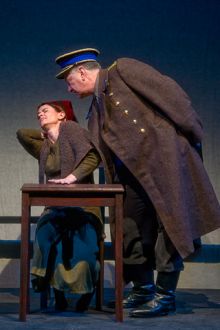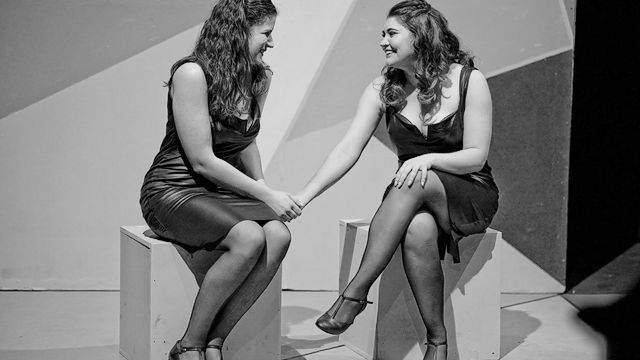The Woman in the Window
The consequence of societal failure to learn the lessons of history underpins this combination of historical and science fiction. In 1950s Stalinist Russia, innocents are routinely arrested, interrogated, and imprisoned or “disappeared” in ideological pogroms, and the politically suspect poet Anna Akhmatova (a historical poet of the era, played with compelling restraint by Karen Vickery), is obliged to appear at her window at two set times daily to prove that she has not left her flat, which she now shares with Lili (played with great intensity by Lainie Hart), who pays her way by helping Anna with chores.
The State shot Anna’s ex-husband merely for being associated with her and has imprisoned her son, and Anna is under house arrest, but her spirit remains defiant. Indeed, she has the force of personality to wrong-foot even her local secret-police commandant, Comrade Korzh (played with remarkable naturalism by Michael Sparks), who, with one of his underlings, regularly raids the flat seeking evidence that Anna is violating a proscription on writing poetry.
 In a dystopic Australia three and a half centuries later, Rachel Sekerov (Zoe Swan), working for the State as a rigidly regimented “entertainer” of those with status, meets and falls in love with the equally naïve Sandor (Michael Cooper), one of a body of poetry researchers (which the State refers to as “poets”), those with access to the only surviving copy — electronic — of the works of past poets, such as Shakespeare. And the “poets” are shortly to become persona non grata.
In a dystopic Australia three and a half centuries later, Rachel Sekerov (Zoe Swan), working for the State as a rigidly regimented “entertainer” of those with status, meets and falls in love with the equally naïve Sandor (Michael Cooper), one of a body of poetry researchers (which the State refers to as “poets”), those with access to the only surviving copy — electronic — of the works of past poets, such as Shakespeare. And the “poets” are shortly to become persona non grata.
Rachel and Sandor being intellectually and artistically malnourished, and Anna, back in old Russia, needing somebody to hear her, the times are ripe for revolution.
The Woman in the Window may be less science fiction or political thriller than it is an engaging exploration of the psychology of state control and individual resistance. Although the connection Rachel and Anna establish is without causal explanation, a combination of careful staging and lighting and adjacent sets helped clarify the characters’ perception and relationships and make it somehow believable enough. If history itself is too dry, we might still learn a thing or two from this very worthy production.
John P. Harvey
Images: (L–R) Alex McPherson and Zoe Swan and ( L–R) Lainie Hart and Michael Sparks, in The Woman in the Window. Photographer: John P. Harvey.
Subscribe to our E-Newsletter, buy our latest print edition or find a Performing Arts book at Book Nook.

